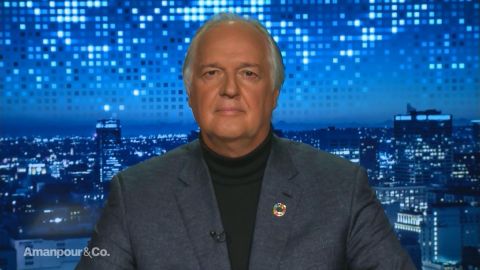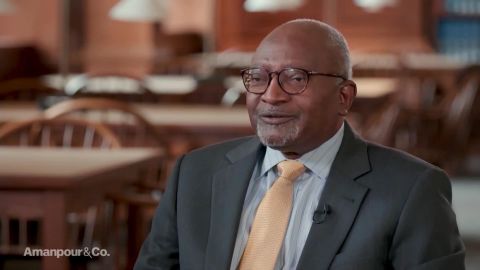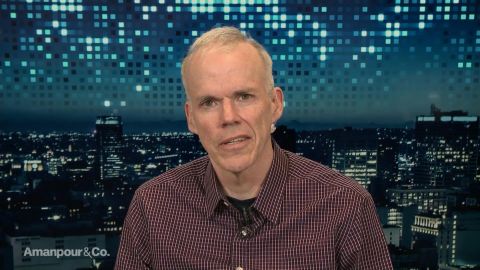Read Transcript EXPAND
CHRISTIANE AMANPOUR: And now: “The United States of America is segregated, and so is pollution” — those words from our next guest, the so-called father of environmental justice, Robert Bullard. As a sociologist in the 1970s, he shone a light on how minority communities in Houston, Texas, suffered most from pollution. Since then, he’s written more than a dozen books on sustainable development, environmental racism, and climate justice. And he’s been talking to our Walter Isaacson in Texas about all of this.
WALTER ISAACSON: I have been absolutely fascinated by the concept of environmental justice. Tell me what that concept means and how you became the father of that.
ROBERT BULLARD, AUTHOR AND ENVIRONMENTAL SCHOLAR: Well, environmental justice embraces the principle that all communities are entitled to equal protection of our housing, transportation, employment, and transportation energy. And so it’s a concept that’s rolled in equal protection, equal access, equal enforcement. And it’s not a fuzzy issue. It’s an issue of the right to live in a neighborhood that’s not overpolluted, a neighborhood where your kids can play outside on the playground that’s not next to a refinery or a chemical plant.
ISAACSON: And that’s how you got into it. It was 1978.
BULLARD: 1978. That was so long ago. And it was an accident. It was an accident. You know, my wife came home one day and said, Bob, I have just sued the state of Texas, and I have sued this company that’s trying to put this landfill in the middle of this suburban middle-class black community in Houston. And she said, I need somebody to collect data for this lawsuit and put the — where the pins are and where the landfills are on a map. And I said, well, you need a sociologist. She said, that’s what you are, right?
(LAUGHTER)
BULLARD: That’s how I got roped into this. I got drafted.
ISAACSON: And you discovered that there were like seven landfills. How many of those seven were in African-American neighborhoods?
BULLARD: Well, what I discovered, from the ’30s up until 1978, that five out of five of the city-owned landfills were in black neighborhoods. Six out of the eight of the city-owned incinerators were in black neighborhoods, and three out of four of the privately owned landfills were in black neighborhoods, even though blacks only made up 25 percent of the population during that period of time. And this is in a city that — it’s the fourth largest city and a city that doesn’t have zoning. So somebody was making these decisions. And what we found is that it was not random. Everybody produces garbage, but everybody doesn’t have to live next to the landfill. And it was not just a poverty thing. The subject of the lawsuit, Bean vs. Southwestern Waste Management, was a middle-class black neighborhood of homeowners; 85 percent of the people owned their homes. And so it was not a poverty park. It was not a ghetto. This was a solid middle-class neighborhood of houses and people and trees.
ISAACSON: The City Council of Houston that’s making that decision back then, what’s the racial makeup of that city council?
BULLARD: All white.
ISAACSON: All seven?
BULLARD: All seven.
ISAACSON: Yes.
BULLARD: So you get this whole idea of environmental justice also means having access to decisions that are being made and making sure that there’s access, and that no one segment of our city or a county or region should be making decisions for other people. And so the idea that this was a policy of not having individuals on the City Council in that room saying, well, let’s not just put all the landfills or the incinerators or the garbage dump in this one area. And so it’s a matter of equity, a matter of fairness and a matter of civil rights.
ISAACSON: And how does climate change affect this?
BULLARD: Well, climate change — if you look at environmental justice, climate change basically overlays this whole issue of who has contributed most and who is going to be impacted the greatest. And if you look at the footprint of climate change — and climate change is more than parts per million and greenhouse gases. It also includes who is most vulnerable. Who is going to have the burden of living in these areas that are going to be hit hard, whether it’s droughts or there’s flooding or whether other kinds of issues. And, again, climate change, sea level rise will exacerbate the inequities that already exist. If people are poor, they’re in low-lying areas that’s prone to flooding, you’re going to get more flooding. You’re going to get more droughts and more disasters. You’re going to get more of issues of the widening gap between haves and have-nots. And you’re going to get this whole piling on effect of not having, you know, a level of resilience to bounce back because of a flood.
ISAACSON: So let’s be specific. You were here for Harvey, right? How many inches of rain did Harvey dump on Houston?
BULLARD: Fifty-two, 53, whatever. Nobody counted on that. I have worked on environmental justice and climate issues and disasters for 40 years, and working with other communities that have been forced to evacuate. I never had to be evacuated until Harvey. In this case, it was very unique for me and very unique for a lot of people, because, in some places, some neighborhoods, some areas had never flooded before.
ISAACSON: How did the city flood, white areas vs. black areas?
BULLARD: Well, if you look at the GIS maps, studies just came out last year showing that the communities that historically that have flooded over a period of time — we’re not talking major storms. We’re talking mostly African-American, Latino areas in terms of the East Side. Divide the city in half. Harvey basically followed that pattern. Even though a large part of the city flooded, the areas that got hit the hardest are the areas that historically have always gotten hit hard.
ISAACSON: Houston is famous for not having many zoning laws. How does that affect things?
BULLARD: Well, as a matter of fact, Houston is a no-zoning city, and it’s very proud of that. It’s unrestrained capitalism. And it means that, historically, it’s the only residential protection land use device is with deed — renewable deed restrictions. But the fact is that we have a lot of our land uses that’s willy-nilly, a lot of building that’s in areas that we probably shouldn’t be building in. And the idea of, how do we make corrective action that’s happened over the last 50, 75 years, it’s hard to do that now. So that means that we have to come up with sensible planning. We have to talk about how we’re going to, in some cases, probably restrict the kinds of development that most cases would be dictated by money, as opposed to some common sense. And so–
ISAACSON: Wait. Give me an example of that.
BULLARD: Well, in terms of a lot of the houses that flooded on the western part of the city were built right up to the reservoirs. And — Addicks, Barker reservoirs. And these — and those houses, we’re not talking low-income, middle-income. We’re talking very well-heeled families, million-dollar, $2 million homes that were built in a floodplain and that were built in the areas that, with an event like Harvey, is bound to flood. And you talk about what it means to provide protection, not just for well- heeled communities, and the idea that, if we can provide the kinds of flood protection and flood mitigation and the kinds of restructuring of our land uses, and allow for some communities to somehow relocate, it has to be a plan that brings a lot of communities to the table. And, historically, Houston has not been a city that has been diverse when it comes to decision-making. It’s been mostly a top-down. And so I think Harvey has brought a lot of rethinking of what that means.
ISAACSON: Has Harvey brought people of different socioeconomic and racial groups together?
BULLARD: Oh, yes. Oh, yes. But you have to look at it and say, it took a biblical flood to bring a lot of the groups and organizations that generally had not worked together on a lot of issues, organizations that work on wetlands and on prairie issues, issues of environment, pollution, industry, transportation. It brought a lot of groups together. We came — almost three dozen groups came together and decided that we need to be talking, we need to be working together. And we came up with this organization named the Coalition for Environment, Equity and Resilience, CEER. And, again, the heart of that whole thinking is an equity lens. And one of the first things we did is, we came together and came up with this framework. And we presented the framework, equity framework, to the county, Harris County. And they basically adopted this whole idea that future development and future funding of projects dealing with Harvey or flood mitigation or going forward must be looked at through an equity lens.
ISAACSON: Houston, how segregated is it racially and economically?
BULLARD: Well, you know, Houston is still segregated. It’s segregated by race, and it’s also segregated by income. And, again, if you look at this whole idea of concentration of white affluent census tracks, or zip codes, you can see that increasing. You can also see the increasing numbers of low-income families, families of color, concentrated in those census tracks, in those areas.
ISAACSON: Wait. Wait. So you’re saying it’s becoming more segregated?
BULLARD: More income-segregated.
ISAACSON: Why?
BULLARD: Well, that’s a big question of the day. And it’s not just a Houston question. We are becoming more and more separate and apart by income. And affluent people feel more comfortable living with affluent people. And, oftentimes, poor people don’t have a choice but live around poor people. And housing choices oftentimes will dictate where people live. And the fact is that Houston and most major cities in this country have a housing affordability issue. And if you have to drive to qualify, which means drive long distances to qualify for housing in terms of ownership, that means that the housing that’s available, people have to settle for less. And more and more people are settling in those areas where they can afford. That means that you’re having more and more concentrated areas with people of color, as well as poor people. Now, that’s not the best way to create healthy, livable, sustainable, resilient cities, but that’s what we get when we let market forces drive it, as opposed to trying to assist and support a sane program of creating more, what — what do they call it, mixed income housing and mixed use.
ISAACSON: Right.
BULLARD: I will tell you another thing. It’s not just the housing being segregated. So is pollution. Pollution is segregated, which means that, as you start getting more and more low-income families and families of color concentrated in areas where there’s lots of pollution, more and more pollution gets put in those areas. And so you get the segregation of income and race, but you also get the income of pollution. And that’s where we say — you know, I wrote a book on this called “The Wrong Complexion for Protection.” And it means that — and I’m not just talking about race. It’s also income. Middle-income African-Americans are more likely to live in neighborhoods — when I say middle income, I’m talking $50,000 to $60,000 — are more likely to live in neighborhoods that are more polluted than whites who make $10,000. You say, how can that be? It means that there is a racial and economic dynamic in housing that allow low-income whites to move into middle-income areas and to exit polluted neighborhoods, whereas institutional racism will keep black families, middle-income, in those neighborhoods.
ISAACSON: After Katrina, we all realized in New Orleans we were in the same boat, and it did bring us together some. And we did rebuild the Lower Ninth Ward, but there was more of an integration of the city. Do you think environmental catastrophes like Harvey will start doing that in places like Houston, make people realize we’re all in the same boat?
BULLARD: Well, you know, I hope we don’t have to wait for a disaster. But it did. And the kinds of — in some cases, these wakeup calls oftentimes are the only thing that will wake us up, and to a reality that — I have a saying, that when we don’t protect the least in our society, we place everybody at risk. We don’t strengthen the levees or we don’t provide flood protection for one segment, we place everybody at risk. When we don’t provide protection in terms of immunization or whatever, then it will place everybody at risk. And so it seems to me that a justice frame, an equity frame should be the logical framework to accept. But, you know, we are a hard-headed society.
(LAUGHTER)
BULLARD: It’s almost like we need a two-by-four to hit us over the head and wake us up and say, aha. And we need those aha moments before disasters hit. But I do think that Houston post-Harvey is a different Houston in terms of thinking, in terms of mind-sets, in terms of thinking about this whole idea that we are a big city, and that we can’t just somehow have communities that are invisible. I wrote a book in 1987 called “Invisible Houston.” Houston in 1987 had the largest African-American population of any city in the South. There were over a half-million black people in Houston, more people than in Atlanta or New Orleans. And so the idea that, even though you had this large black population, the black community was invisible when it came to landfills, incinerators, was invisible when it came to economic development, providing the kinds of growth and planning that will build communities that was — that had those things. Middle-income African-American communities in Houston didn’t have the same kind of amenities as the low-income white communities. So the idea that invisible, that invisibility must be erased, and we must make all communities visible, so that they can join in this new green energy economy and post-disaster to talk about building resilience. There has — you know, when we talk about climate, we talk about climate justice. When we talk about the environment, we talk about environmental justice. When we talk about energy, we talk about energy justice. All these things, when you look at the justice framework, it can apply to almost all the aspects when we talk about issues around sustainability.
ISAACSON: In Houston, and to some extent in all of Texas, the energy industry just doesn’t even like to utter the words climate change. Is it possible to move towards environmental justice without confronting climate change head on?
BULLARD: No, it’s impossible. When we talk about climate change and we talk about environmental justice, when we start connecting, you know, the tissue of climate responsibility and the issue around vulnerability, you can’t get around solutions, real solutions, without talking about justice inequity. That’s why the climate justice frame is a frame that, as I said, is more than just looking at greenhouse gases in parts per million. It brings in the issue of which communities are vulnerable, which communities have contributed least to the crisis, but are feeling the pain right now, first, worst, and longest. That’s true here in Houston. It’s also true in Texas. It’s also true in the United States and globally, this whole issue of vulnerability and the whole issue of, how can we make sure that our plans do not further marginalize already vulnerable populations by creating plans that somehow exacerbate that vulnerability and create more problems for that — quote — “invisible group,” the group that may not necessarily be in the room when they’re deciding what to build and where to spend moneys. That’s the justice part. And even though the state of Texas may not recognize climate change as a concept, the whole issue of vulnerability and the whole issue of severe weather events, you look at the map, and there’s no way for the state not to look at where the hot spots are and where the solutions need to be, where the mitigation and the adaptation will have to occur, no matter whether they believe in it or not. And that’s why I tell people, I said, believing in climate change is not — it’s not the issue. It’s like asking somebody, do you believe in gravity? And it’s not — believing in gravity is not — is not an issue. If you climb up a 50-story building and jump out, gravity will kick in. And so whether you believe it or not, it’s real.
ISAACSON: Dr. Bullard, thank you so very much.
BULLARD: My pleasure. My pleasure. Thank you.
About This Episode EXPAND
In this climate special, former Unilever CEO Paul Polman joins Christiane to discuss the responsibility of businesses to protect the planet. Plus, environmentalist Bill McKibben assesses the urgency of the climate crisis and Walter Isaacson interviews Robert Bullard, the father of environmental justice.
LEARN MORE


